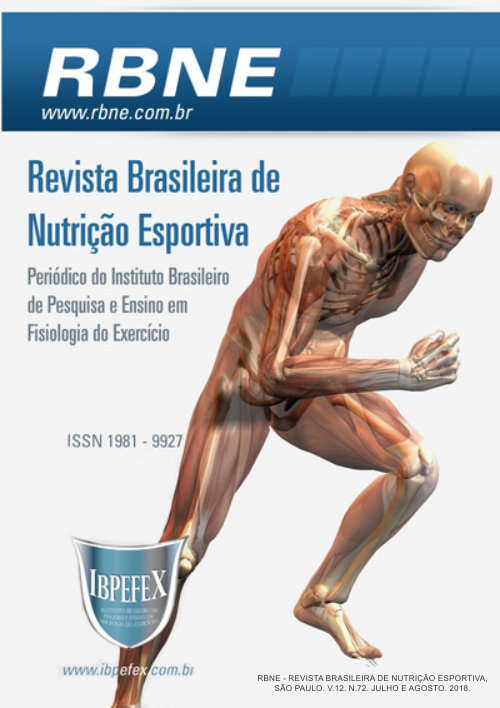Nutritional profile and frequency of consumption of alcoholic beverages among teenagers volleyball players of Joinville-SC
Abstract
Introduction: The practice of physical activity is fundamental for health, especially during adolescence. However in this period, with the insertion in social environment is the beginning of the consumption of alcoholic beverages. Objective: To characterize the nutritional profile and the frequency of alcohol consumption among adolescent volleyball players. Methodology: Cross-sectional quantitative study and non-probabilistic convenience sampling where 20 adolescents between 15 and 18 years old were evaluated. Variables of weight (kg) and height (cm) were collected to classify BMI according to WHO growth curves (2007). Two questionnaires were applied, one for the analysis of dietary habits adapted from Martins (2009) and another to verify the consumption of alcoholic beverages adapted from Pinto (2008). Results: In relation to the nutritional profile, 65% of participants were eutrophic and 35% were overweight. As for general eating habits, 85% consume fruits, 50% consume vegetables and 100% industrialized foods. Regarding the consumption of alcoholic beverages, 65% reported consuming, being 43% in social events and 28% in the presence of friends. The most consumed drink was vodka with 54% followed by beer with 27%, also preferred was vodka with 53%. Conclusion: There are few studies related to the subject of this research, this being an original article. The results provide data that parents and health professionals should be concerned about, and the public's awareness is needed.
References
-Aiken, A.; Clare, P.J.; Wadolowski, M.; Hutchinson, D.; Najman, J.; Slade, T.; Bruno, R.; Mcbride, N.; Kypri, K.; Mattick, R.P. Age of alcohol Initiation and progression to binge drinking in adolescence: A Prospective Cohort Study. Alcoholism: Clinical and Experimental Research. p. 1-11. 2017.
-Alves, C.; Lima, R.; Impacto da atividade física e esportes sobre o crescimento e puberdade de crianças e adolescentes. Revista Paulista de Pediatria. Vol. 26. Num. 4. Salvador. p. 383-391. 2008.
-Azevedo, F.T.; Bonfante, L.S.; Silva, M.F.N.; Silva, M.P.; Silva, F.S.M. A importância da Nutrição para o atleta de competição. 2009.
-Brasil. Ministério da Saúde. Orientações para a coleta e análise de dados antropométricos em serviços de saúde: norma técnica do sistema de Vigilância Alimentar e Nutricional-SISVAN. Brasília. 2011.
-Confederação Brasileira de Voleibol (CBV). Regras Oficiais do Voleibol. 2015-2016.
-Coutinho, E.S.F.; Santos, D.F.; Magliano, E.S.; Bloch, K.V.; Barufaldi, L.A.; Cunha, C.F.; Vasconcellos, M.T.L.; Szklo, M.; ERICA: padrões de consumo de bebidas alcoólicas em adolescentes Brasileiros. Revista de Saúde Pública. Vol. 50. p. 1-9. 2016.
-Filho, V.C.B.; Campos, W.; Lopes, A.S.; Prevalência de consumo de álcool e tabaco entre adolescentes brasileiros. Revista de Saúde Pública. Vol. 46. Num. 5. p. 901-917. 2012.
-Instituto Brasileiro de Geografia e Estatística. Pesquisa Nacional de Saúde do Escolar (PeNSE). Rio de Janeiro: IBGE. 2009.
-Irwin, C.; Leveritt, M.; Shum.; Desbrow, B.; The effects of dehydration, moderate alcohol consumption, and rehydration on cognitive functions. Alcohol Journal. Vol. 47. p. 203-213. 2013.
-Mcardle, W.D.; Katch, F.I.; Katch, V.L. Nutrição para o esporte e o exercício. 3ª edição. Guanabara Koogan. 2014.
-Mahan, L. K; Escott-Stump, S.; Krause: alimentos, nutrição e dietoterapia. Rio de Janeiro. Elsevier. 2005.
-Malta, D.C.; Machado, I.E.; Porto, D.L.; Silva, M.M.A.; Freitas, P.C.; Costa, A.W.N.; Campos, M.O. Consumo de álcool entre adolescentes Brasileiros segundo a Pesquisa Nacional de Saúde Escolar (PeNSE 2012). Revista Brasileira de Epidemiologia. p. 203-214. 2014.
-Marcondelli, P.; Costa, T. H. M.; Schmitz, B. A. S. Nível de atividade física e hábitos alimentares de universitários do 3º ao 5º semestres da área da saúde.Revista de Nutrição. Vol. 21.Num. 1.p. 39-47. 2008.
-Marshall, E.J. Adolescent Alchohol Use: Risks and Consequences. Alcohol and Alcoholism. Vol. 49. Num. 2. p. 160-164. 2014.
-Martins, M.J.R.L.; Hábitos alimentares de estudantes universitários. Universidade do Porto. Porto.2009.
-Mielgo-Ayuso, J. Dietary intake habits and controlled training on body composition and strength in elite female volleyball players during the season. Applied Physiology, Nutrition and Metabolism. Vol. 40. p. 827-834. 2015.
-Neves, K.C.; Teixeira, M.L.O.; Ferreira, M.A. Fatores e motivação para o consumo de bebidas alcoólicas na adolescência. Revista de Enfermagem. Vol. 19. Num. 2. p. 286-291. 2015.
-Oliveira, D.G.; Almas, S.P.; Duarte, L.C.; Dutra, S.C.P.; Oliveira, R.M.S.; Nunes, R.M.; Nemer, A.S.A.; Consumo de álcool por frequentadores de academia de ginástica. Jornal Brasileiro de Psiquiatria. Vol. 63. Num. 2. p. 127-132. 2014.
-Organização Mundial da Saúde. Curvas de crescimento. 2007.
-Pacheco, B.M.; Filho, A.D.R.; Santini, E. Impacto da prática regular de exercício físico sobre aspecto alimentar. Revista Brasileira de Nutrição Esportiva. Vol. 6. Num. 35. p. 376-380. 2012. Disponível em: <http://www.rbne.com.br/index.php/rbne/article/view/336>
-Pereira, L.; Stanzani.; Souza, M.G.; Silva, M.S.; Bezerra, C.C.; Alvarenga, M.L. Judocas em fase de crescimento competem em categorias de peso adequadas para a sua idade. Revista Brasileira de Nutrição Esportiva. Vol. 9. Num. 54. p. 563-571. 2015. Disponível em: <http://www.rbne.com.br/index.php/rbne/article/view/584>
-Pinto. L.F.N. Questionário –“Alcoolismo no feminino: O consumo de bebidas alcoólicas em alunas universitárias –uma amostra da FCS-UFP do Porto.” Universidade de Fernando Pessoa. Porto.2008.
-Silva, F.M.; Menezes, A.S.; Duarte, M.F.S. Consumo de frutas e vegetais associado a outros comportamentos de risco em adolescentes no Nordeste do Brasil. Revista Paulista de Pediatria. Vol. 34. Num. 3. p. 309-315. 2016.
Authors who publish in this journal agree to the following terms:
- Authors retain the copyright and grant the journal the right of first publication, with work simultaneously licensed under the Creative Commons Attribution License BY-NC which allows the sharing of the work with acknowledgment of the authorship of the work and initial publication in this journal.
- Authors are authorized to enter into additional contracts separately for non-exclusive distribution of the version of the work published in this journal (eg, publishing in institutional repository or book chapter), with acknowledgment of authorship and initial publication in this journal.
- Authors are allowed and encouraged to post and distribute their work online (eg, in institutional repositories or on their personal page) at any point before or during the editorial process, as this can bring about productive change as well as increase impact and impact. citation of published work (See The Effect of Free Access).






